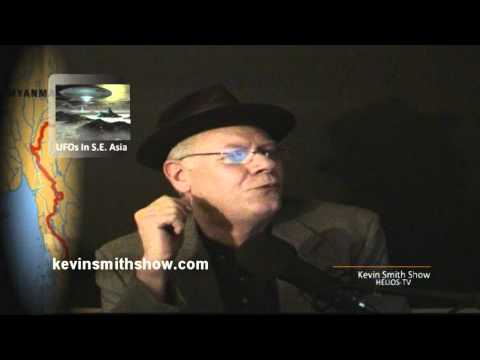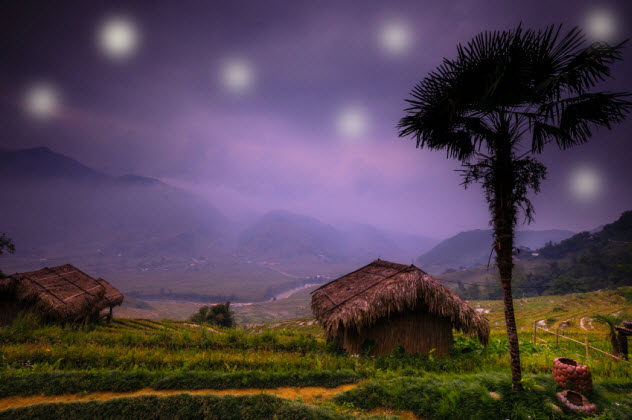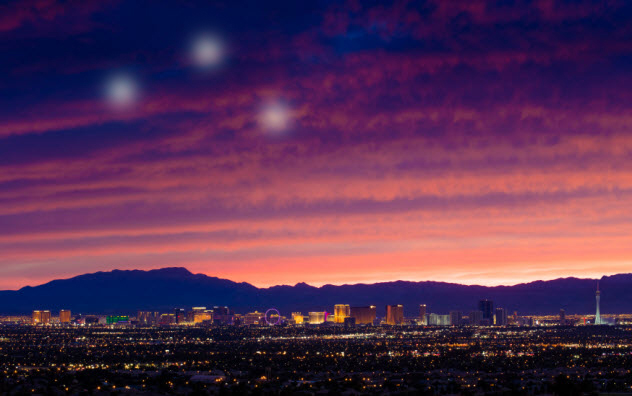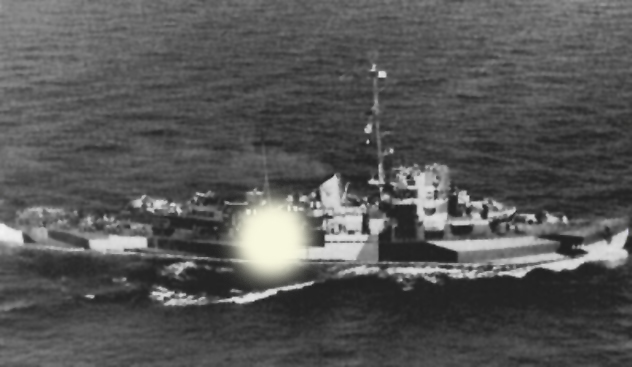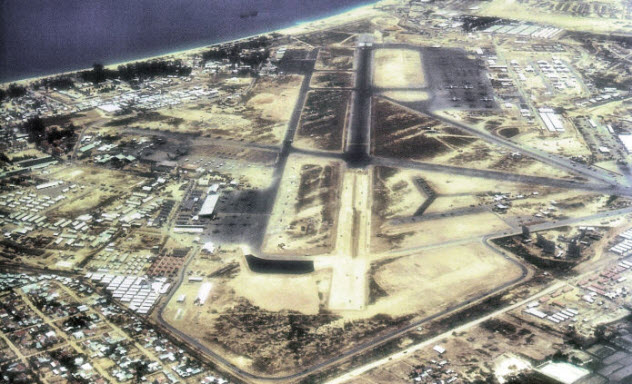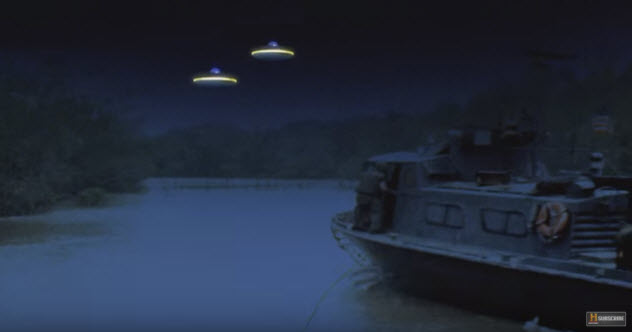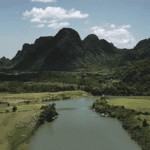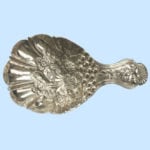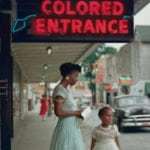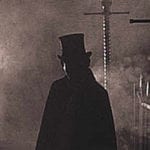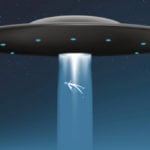10 HMAS Hobart
Although the North Vietnamese had helicopters early in the war, they rarely used helicopters by the middle of the war. Thus, a lot of the UFO sightings from the war revolve around bright floating objects because crews knew that they couldn’t be North Vietnamese helicopters. In June 1968, Australian spotters saw 30 floating lights near the DMZ. Fearing another Tet Offensive–style attack, NATO forces promptly scrambled F-4 fighters and patrol boats to intercept. The lights turned seaward and came under fire from various ships in the area. Unfortunately, a US Navy swift boat got hit by friendly missiles and sank, killing five of the crew. Amid the confusion, the Australian destroyer HMAS Hobart sat ready to engage the enemy. At 3:30 AM, the commander called “Action Stations” when the radar room detected an airplane coming in fast with no IFF (Identification, Friend or Foe). The plane opened fire on the HMAS Hobart, damaging the ship and killing crew members. Throughout the confusion, the F-4s tried to make contact with the floating lights. But there were only a few inconclusive engagements. Later that night, the pilots returned to their base. The next morning, no wreckage of enemy helicopters was found, even though there was a flurry of antiaircraft fire trying to intercept the lights. Eventually, the incident was chalked up to atmospheric disturbances or possible helicopter activity. General George S. Brown, commander of the 7th US Air Force, went on record after the war with his beliefs. Although the government had grouped all UFO sightings under the heading of enemy helicopter activity, Brown believed that the Hobart incident was a case of UFO interference in military operations.
9 Pete Mazzola’s Sighting
At the beginning of the Vietnam War, Pete Mazzola was a young soldier. Although not interested in UFOs at the time that he shipped off to the front, Mazzola experienced sightings that made him believe in UFOs. Throughout his tour, Mazzola noted that he saw many “meteors” that moved in a way that was unlike a normal shooting star. Later in the war, he even had a direct experience with a UFO. While on patrol, his squad got pinned down by enemy soldiers. They stayed low and hid, hoping to find a way out of the mess. As they were trying to figure out a way home, they saw bright objects rise up over the paddy fields and hover in the air. When the objects rose in the air, they took fire from the American warships to the south. But surprisingly, the Vietcong also started shooting at the floating lights. Neither side could touch the objects. Mazzola recalls seeing the shells explode just short of the lights, even though they were right on target. Whatever the lights were, neither the Americans nor the Vietcong recognized them as friendly. The experience had such an effect on Mazzola that he founded an organization called the Scientific Bureau For Investigation after the war. Based out of New York, Mazzola dedicated his life to researching UFO experiences and other paranormal events.
8 Coyne Incident
Although it did not occur in Vietnam, the Coyne incident of 1973 was a classic case of a UFO sighting by the US Air Force that occurred during the Vietnam era. The incident is named after Major Larry Coyne, the commander of the helicopter involved. A four-man army reserve crew was conducting a routine training flight at 760 meters (2,500 ft) above Mansfield, Ohio, when they spotted a red light in the distance approaching their helicopter. They braced for impact, but the object stopped right in front of the helicopter. Once the crew recovered from the collision scare, they realized that the object was shaped like a cigar. From the undercarriage, a green light illuminated the helicopter cabin. After a few seconds, the strange object flew off. As the crew decided to return to base, they noticed that they had climbed a few thousand feet during the few seconds of the incident. The climb occurred at a faster speed than they would normally be able to achieve. But the climb was especially strange because the pilot had set the controls for a 20-degree dive. All of the crew members confirmed the story, and people on the ground also stated that they had seen something strange near the helicopter. In UFO circles, the Coyne incident is considered to be one of the most reliable UFO stories because multiple witnesses shared their stories. It remains one of the most interesting sightings of the Vietnam era.
7 Skylab 3 UFO
Another incident that did not occur in Vietnam but still occurred during the war was the UFO sighting by Skylab in 1973. The Skylab 3 mission was plagued with problems, including a frequent loss of radio contact. Right before the three astronauts on Skylab returned to Earth, they were out of radio contact and noticed something strange while gazing out of the wardroom window. Grabbing his camera, astronaut Owen Garriott took a picture of the object, which looked weird and squiggly. After radio contact came back, the astronauts told CAPCOM that they had seen a red light oscillating outside the space station. Then it got washed out by the Sun and became invisible. It was the closest, brightest object that they had seen during the mission. After returning to Earth, Garriott stuck by his story. In his debriefing, fellow astronaut Jack Lousma mentioned that this was the only satellite of the many observed during the mission that looked like something not from Earth. In recent years, skeptics have chalked up the picture to debris or optical tricks, but it remains one of the earliest UFO sightings in space.
6 Shag Harbor, 1967
One of the weirder sightings from the Vietnam era was the Shag Harbor incident in 1967 in Nova Scotia. On the night of October 4, multiple witnesses reported that they saw a bright object descend from the sky and crash into the harbor. The first sighting was by a Canadian DC-9, which reported a large rectangular object falling from the sky that was trailed by explosions. Locals also reported it to nearby authorities. Soon, officers arrived on the scene, thinking that an airplane had crashed into the ocean. Organizing with local fishermen, the authorities searched for debris or survivors. Neither was found. Checking with both Canadian and American government agencies, the Canadians determined that there were no missing aircraft on the Eastern seaboard. They could not figure out where the object had come from. Locals described it as moving quickly and sounding like a bomb exploding overhead. But nobody was able to figure out what the mysterious aircraft was. Everybody just decided that it was a UFO.
5 Las Vegas 1962 Incident
The military was already experiencing incidents with UFOs as they were building up to war in Vietnam. For example, in 1962, there was a UFO crash at Nellis Air Force Base in Las Vegas. Initial reports stated that radar had tracked a fast-moving object over Mesquite (near Las Vegas) but had lost contact after that. Days later, witnesses started to come forward with their own stories of the incident. Contradictory stories popped up about where the mysterious object had landed. Some people believed that it had crashed in Utah. Others believed that it had set down near a power station in Eureka, Nevada. Still others reported that they had seen an explosion over Mesquite. Most sources indicated that the object had crashed somewhere near Las Vegas. Multiple people called the Las Vegas sheriff’s office to report odd lights in the sky. Near Las Vegas, other witnesses talked about seeing the object explode over the desert. Residents around the city led search teams into the desert to find the crash site. But nobody ever found debris or evidence of a crashed object. When the US government ended their investigation, they noted that the radar contact was true, but there was no way to trust the visual sightings. Thus, the case was impossible to analyze.
4 USS Kilauea Sighting
Many of the UFO cases in the Vietnam War are not verifiable and are mostly passed around as stories between soldiers. One such story is that of crewman Norman Burns’s odd encounter with a water UFO near the end of the war. At the time, he was serving on the USS Kilauea during a patrol of the Indian Ocean. One night in 1974, Burns and a friend were standing on the deck of their ship, idly watching another ship in front of them in formation. The ship was kicking up a trail of phosphorus algae behind it. Suddenly, the trail began to glow and got extremely bright. Out of nowhere, a ball of light leaped out of the water, rolled over the destroyer, and dived back into the water. Burns recalls that the ball was 30–60 meters (150–200 ft) in diameter. Everybody on watch also saw the light, but no one was able to identify what it was.
3 B-52 Shot Down By A UFO
Another interesting UFO story in Vietnam revolves around a crashed B-52 bomber. The paper trail for this story is vague, but it remains a common tale in UFO circles. The incident is a part of Project Grudge, a US Air Force investigation of UFO sightings which supposedly ended in 1951. But UFO researchers believe that it was still operating in Vietnam. In the 1970s, Green Beret Captain William English was assigned to Laos to investigate a downed B-52 bomber. The aircraft was lost under mysterious circumstances, and the US Air Force was eager to retrieve evidence from it. Captain English successfully found the airplane, which seemed in unusually good shape. The only damage on the bomber was normal damage expected from a crash landing. When English opened the hatch, he found all the crew still strapped in their seats but horribly disfigured and mutilated. There was no other damage in the cockpit. English collected samples and turned the bodies in for autopsy. But after the incident, the Laos government deported him. Whether or not this story is true, it is an interesting tale from the end of the Vietnam War.
2 Nha Trang Base 1966 Sighting
The US base of Nha Trang was an important strategic location for the US. In 1966, it was also the sight of one of the most interesting UFO encounters of the war. Unlike other encounters, this one had a few thousand soldiers as witnesses. During a night without fighting, the American GIs got together to watch an outdoor movie. Bulldozers were working on hills nearby, and two Skyraider attack planes were warming up their engines for a mission. An oil tanker was also close by in the harbor. As the soldiers watched their movie, the sky to the north suddenly lit up. Initially, the soldiers thought that it was a flare. But suddenly, the light moved toward the base. Eyewitnesses reported that the light moved erratically, speeding up and slowing down. It was flying at around 7,600 meters (25,000 ft). Suddenly, the light stopped and dived downward, hovering 90–150 meters (300–500 ft) off the ground. When the light descended, all the electrical equipment in the base shorted out, including the engines on the Skyraiders and the bulldozers. The light hovered for a bit and then shot straight up, disappearing into the night sky. Eventually, the power came back, but nobody could understand what had happened.
1 Patrol Boat Attack And Only Known UFO Photograph
In 1968, two patrol boats in the DMZ between North and South Vietnam spotted a couple of UFOs approaching them. The two UFOs stopped and hovered over the first patrol boat. Crew members of the second patrol boat watched as a flash of light from the UFOs completely engulfed the first boat and destroyed it in a huge explosion. In a separate incident, the only known photograph of a UFO from the Vietnam War was taken in 1967. An American serviceman was riding in the back of a truck in Chu Lai when he spotted an odd object. With his Electro-35 Yashica camera, the soldier took a picture of a cylindrical object hovering just above the country road. These sorts of experiences made UFO stories somewhat common during the Vietnam War. Zachery Brasier doesn’t believe UFO stories, but he finds them fun to read.
